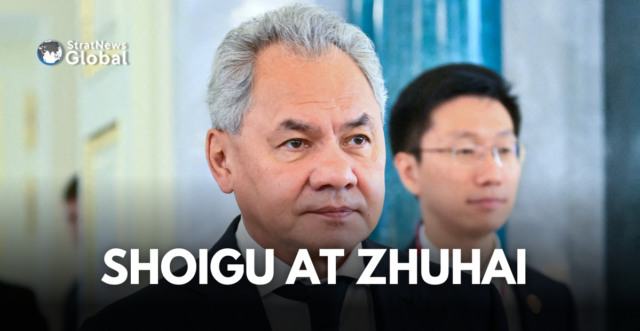China’s Zhuhai Air Show concluded with a strong focus on military hardware, reflecting China’s growing influence and its strategic alliances with countries like Russia and Saudi Arabia. As the commercial side took a smaller role, military technologies—including stealth fighters, drones, and missile systems—drew significant attention, underscoring China’s commitment to modernising its defence capabilities.
Strengthening China-Russia Ties with Su-57 Jet and Security Delegations
The show featured Russia’s Su-57 stealth jet in its first display outside Russia, viewed by Sergei Shoigu, Secretary of Russia’s Security Council, marking a notable symbol of China-Russia military ties. Shoigu’s visit included annual security consultations with Chinese officials, highlighting a partnership that has grown as Russia faces isolation from Western nations over its invasion of Ukraine.
China also welcomed a Saudi delegation, further broadening its influence and partnerships in the defence sector. The Global Times, a state media outlet, emphasised these international displays as evidence of China’s pull on the global stage, even as it becomes more isolated from Western arms markets.
China’s Military Strategy: Anti-Access/Area Denial (A2AD) Focus
A highlight of the show was the debut of China’s J-35A stealth fighter and advancements in drones, helicopters, and missile systems. These innovations reflect China’s A2AD (Anti-Access/Area Denial) strategy, which seeks to prevent adversaries from entering or operating within Chinese-claimed territories. Malcolm Davis, a senior analyst at the Australian Strategic Policy Institute, pointed out that these new technologies enhance China’s ability to counter U.S. and allied forces, showcasing China’s long-term military strategy.
COMAC’s C929 Launch with Air China and New Orders for Regional Jets
On the commercial aviation front, state-owned COMAC announced Air China as the first customer for its C929 widebody jet, a move that strengthens China’s entry into the global aviation market. The rebranded ARJ21, now called the C909, was also revealed as part of COMAC’s efforts to build a cohesive brand lineup.
COMAC shared additional order news: Hainan Airlines signed for 60 C919 narrowbody jets and 40 C909s, while Colorful Guizhou Airlines committed to 30 C909 jets. These orders mark significant support from domestic carriers as COMAC competes against Airbus and Boeing for a slice of China’s aviation market.
Airbus, Embraer, and International Aviation Partnerships
Airbus affirmed its confidence in the Chinese market despite potential trade tensions, highlighting smooth progress in the certification of its A330neo widebody jet in China, with the first deliveries anticipated in 2025. Meanwhile, Brazilian planemaker Embraer, which specialises in regional aircraft, expressed optimism for deeper supply chain partnerships with Chinese suppliers. This aligns with Brazil’s broader strategic goals, as Brazilian President Luiz Inácio Lula da Silva aims to expand China-Brazil trade ties.
Looking Ahead: China’s Expanding Role in Global Aerospace
The Zhuhai Air Show underscored China’s growing aerospace and military ambitions, showcasing its modernised military capabilities alongside key advancements in commercial aviation. With expanded alliances, notable partnerships, and a focus on A2AD military strategy, China is positioning itself as a significant player in both global defence and aviation industries, signalling its long-term intentions to strengthen its role on the world stage.
(With inputs from Reuters)
















